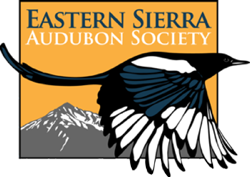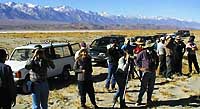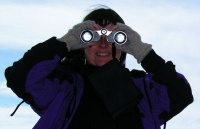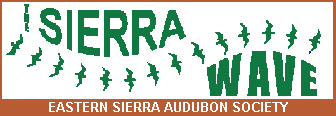
Eastern Sierra Audubon
Sierra Wave Newsletter
Volume 31, Number 3
January-February, 2013
Contents
- Events:
- Features:
- Reports:
- Business
Events
February 6th - The Birds of Cuba with Matthew Matthiessen
Join us for what is sure to be a fascinating program at 7pm on Wednesday, February 6th at the White Mountain Research Station. Matthew is known for his engaging manner, stunning photos, and impressive command of his subject.
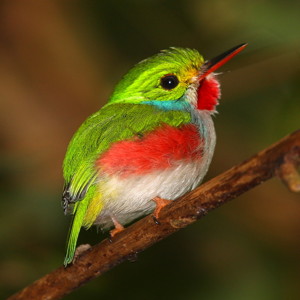
Cuban Tody, photo by Matthew Matthiessen
Cuba has long fascinated Americans both for its culture and its history. Formerly a vacation playground, it has been "off-limits" for Americans for more than 50 years. As a result, most people aren't aware of its equally fascinating birdlife. Although only separated from Key West by 90 miles, there are many species of birds in Cuba that cannot be found in the US including many Caribbean specialties as well as 28 endemic species (found only on Cuba). These endemics include a stunning trogon, two warblers and the smallest bird on earth, the Bee Hummingbird. During this program we will explore some of the culture and history but will focus on the birds. We will see many of specialties including almost all the endemics. Please come and enjoy an evening with "The Birds of Cuba."
Matthew Matthiessen is the Vice President of Eastern Sierra Audubon and resides in Mammoth Lakes where he is the Controller at Mammoth Hospital. He began birding as a boy living in Thailand and has retained a fondness for international birding ever since. His travels have led to many unforgettable experiences: he has lived through two bloody coups, one successful (Thailand) and one not (Zambia). He has been charged on foot by an elephant, stalked by a lion, targeted by a crocodile, and has kissed a cobra. In addition he has push-started a Jeep in the middle of a lion pride, had the spotlight die while next to a leopard, caught a 14 foot python, and almost tripped over a sleeping silverback gorilla. However, he says by far the most exciting thing was giving his first program to ESAS last year. :)
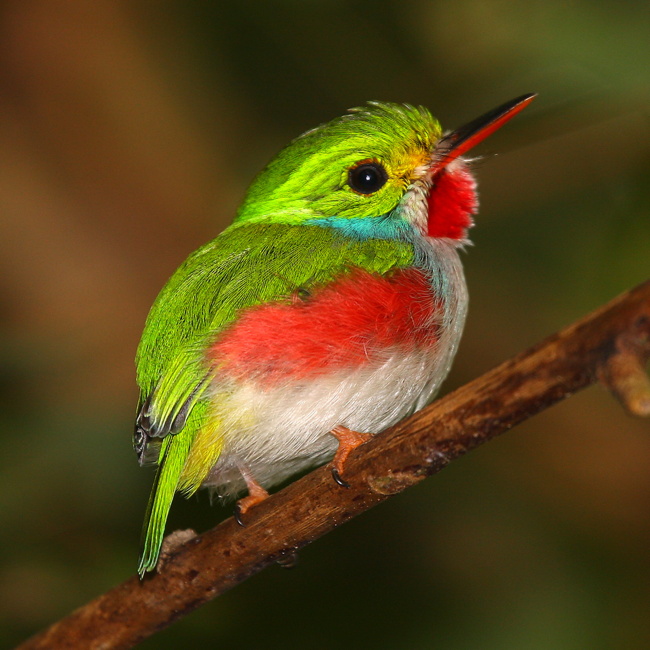
Cuban Tody, photo by Matthew Matthiessen
The program is free of charge and the public is welcome!
For more information contact Jenny Richardson (email jennyn63@gmail.com or call 760-920-8541). Also, check back to this page for updates and the exciting list of speakers for the 2013 season. Everyone is welcome to attend all programs!
Back to Top
Future Programs (schedule subject to change):
- April 11, 2013 - Bob Steele: Birds of Southeast Asia
- May 2013 - Adam Riley: International Birding
- July 2013 - Picnic/Program
- September 2013 - Laura Cunningham: Reptiles and Amphibians of the Great Basin
- October 2, 2013 - Kristie Nelson: Bird Research on the Farallon Islands
Everyone is welcome to attend all programs!
Back to Top
Upcoming ESAS Field Trips
McNally Canal Birding, Saturday, January 26th
Leader: Larry Nahm
It's not too early to look for migrants! Species such as Cinnamon Teal may already have arrived in the Owens Valley. Some hawks and owls may be preparing to nest. We'll scan flocks of sparrows and Horned Larks in an effort to find unusual birds.
The leisurely two-mile walk begins at 8:30 a.m. near the point where the Silver Canyon Road crosses the canal just east of Laws. Bring water, warm clothes, snacks, and binoculars. Spotting scopes will be useful. We'll look at Farmer's Pond before concluding at noon. For more information call leader Larry Nahm at 872-4125.
Back to Top
Sierra Nevada Bighorn Sheep Foundation Fundraiser and Field Trip, February 16th & 17th
Field Trip Leader: Jon Wehausen
Sierra Nevada Bighorn Sheep Foundation will host a fundraiser on Saturday, February 16, 2013 at The Mountain Light Gallery (106 S Main Street, Bishop). Please join in for an evening of fine art, light refreshments, conversation about conservation, and a chance to win terrific prizes via raffle and silent auction. John Wehausen, the leading authority on Sierra Nevada bighorn sheep, will lead a bighorn tracking field trip the day after the party on Sunday, February 17. For more information and to purchase tickets, visit www.sierrabighorn.org or www.sagetosummit.com, or see the article below. Don’t miss the chance to learn more about this inspiring new alliance of art and science in the Eastern Sierra.
Back to Top
Big Pine Winter Wildlife Tour, Saturday, February 23rd
Leaders: Tom and Jo Heindel
Tom and Jo Heindel's popular auto tour annually covers the area between Klondike Lake and Tinemaha Reservoir. Elk, mergansers, golden and bald eagles, tundra swans, bluebirds and creepers are examples of species which could be seen.
Meet at 8:00 am. at Glacier View Campground off U.S. 395 just north of Big Pine. Bring water, snacks, warm clothing, binoculars, scopes. The outing should end mid-day. For more information please call the leaders at 938-2764.
Back to Top
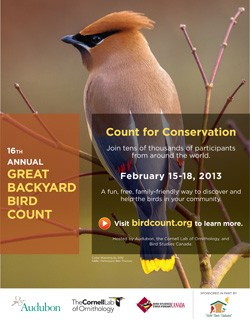
Click image to download a poster
Great Backyard Bird Count 2013
If you want to count more birds, and contribute to more citizen science, here's another bird count - a world-wide event that takes place annually.
The Great Backyard Bird Count is an annual 4-day event that engages bird watchers of all ages in counting birds to create a real-time snapshot of where the birds are. The 2013 GBBC will take place Friday, February 15, through Monday, February 18. Please join us for the 16th annual count!
Everyone is welcome, from beginning bird watchers to experts. It takes as little as 15 minutes on one day, or you can count for as long as you like each day of the event. It’s free, fun, and easy — and it helps the birds.
For more information, see the Great Backyard Bird Count website and sign up!
Back to Top
Features
President’s Message
“You fellas need to figure this out”
— Joe Torre

Janus, January's namesake
I have been thinking about the Roman image of Janus; the two faced figure looking forward and backward at the same time. It comes to mind at this time of the winter solstice as we look back on the lengthening nights and increasing cold and forward to return of light, warmth and new growth. I am fascinated by the idea that, long ago, people figured out the exact day on which the cycle reversed. You could only check your work once a year and, at first, there may not have been any certainty about where you would be on that day. How important to know initially, that the decline of fall into winter would not last forever. But it seems to me to be a daunting task to pinpoint the turn-around.
What does the Janus in me look back on and why? Does the past truly tell us what to expect or fear in the future or is it a thing which we must find the courage to disregard in order to go forward? The answer, of course, is neither and both.
I think about these things in connection with Owens Lake. A few years ago, I wrote that I was haunted by Owens Lake. At the time, I was referring to the landscape: to the combination of heavy industry, the enormous irrigation system, bleached playa, and artificial ponds with stilt-legged birds by the thousand. The parts are so incongruous that I spent hours trying to merge them into a single picture. Now, I am haunted by Owens Lake, the process. It has been nearly five years since Eastern Sierra Audubon and others convened the first meeting aimed at creating a master plan for the future of the lake and its wildlife. I grimace now when I think of how simple and straight-forward a proposition I thought that to be.
Now, my Janus face sees an almost endless complexity. No single thing at Owens Lake sits in its own vacuum and the lake itself is but a part of a larger web of policies and interests, of water policy and budgets, and conflicting and conflicted ways in which various stakeholders see themselves. On one hand, the process has achieved some wonderful outcomes, not the least of which has been an appreciation and understanding among divergent parties of at least a part of the pressures and constraints faced by those at the table. A workable, cutting edge concept emerged which appears well suited to describing and protecting the avian wildlife at the lake and an abiding commitment to that protection has been agreed to by everyone involved. There has been a recognition that the amount of water which makes its way to the lakebed needs to be reduced and what seems like a path to achieving that reduction without losing habitat value has emerged after hours of hard and imaginative thinking by people who may have been surprised to see themselves working so productively together.
So these parts of this history give rise to an expectation on the part of the other Janus face that success can be achieved. But not so fast; the long, long history of which Owens Lake is a part raises a troubling counter argument. Parties perceive there to be important interests beyond achieving consensus on the lake which demand that they pursue more self- directed courses. These divergences are frightening. People with many more years than I in this arena tell me history should teach me of the folly of trying to work this through; looking back should teach that a reasonable expectation should be of frustration.
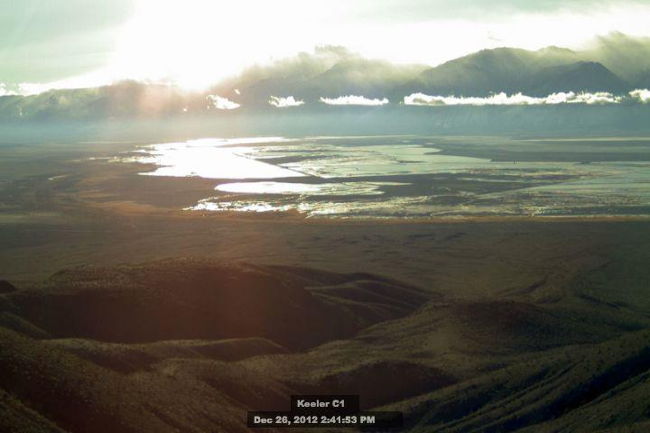
Owens Lakebed, shining with promise from afar, much more complex close up
An interesting thing about Janus is that the image pays little interest to the space in the middle and what goes on there. There is past and there is future. In some images there is just a thin line between the two. What of the present? Is this moment so fleeting that it is merely a connection between the two Janus visions? I want to try to live in the moment. It is reportedly a very actualizing perspective to maintain. But it is difficult in the best of circumstances. It is really hard with this business at the lake, but I guess it is essential. The present demands holding so many things in a state that resembles juggling knives. The belief in good works, done in good faith, by people who have committed to try to find mutual benefit sails in the air with a history which suggests it would be foolish to trust that promise. Good things which clearly could be accomplished by people of good will and commitment, rotate among clear signs of how fragile those things are in the real world. There is reason for hope and reason for despair.
So in this moment, we resolve to continue and meet in January to see how the context surrounding this planning effort may or may not have changed; what has become too complicated or must await resolution in some room far removed from the home of the Avocets. If there are things that can be worked on, we need to see if we can bring ourselves to do that. If there are ways in which the situation can be improved, we should find them.
The trick is to understand that the past urges me to be cautious without becoming imprisoned by fear and mistrust and that the bright promise I want to see in the future does not blind me to the fact that there are real serious differences to be respected in a way that does not preclude serious effort to find commonality.
Looking out the window at the Whites, there is a sense in which all this sound and fury seems feeble contrast to the landscape in which we live. It would be easy to get lost in that if not for the concentration required to keep all those knives in the air.
Pete Pumphrey
ESAS Welcomes New Board Members:
Santiago Escruceria, Bart Godett, Ann Hoffmann and Lacey Greene
We have been undergoing a huge transition in the past year or so - several wonderful, dedicated, long-time board members have been "retiring" from the board, and several wonderful, dedicated, new board members have stepped in. We are still juggling positions, and we always welcome new board members. You don't have to sign up for a specific position to be on the board - you can be a "member at large" or general board member - this is important for having people willing to volunteer for projects or to step in to fill positions as needed.
Our new board member Bart is training to replace Bill Mitchel, our long-time treasurer; Santiago is on our education committee; Ann has volunteered to be secretary and is joining the scholarship committee, along with Lacey. Thank you all for volunteering your time and effort to Eastern Sierra Audubon!
Back to Top
Fall 2012 in Inyo County Pushed the Envelope
[Click on any photo or linked bird name to see all in a slideshow]
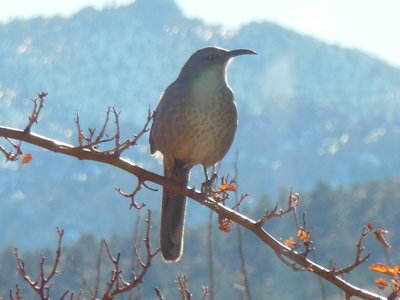
Curve-billed Thrasher, "trying to become a resident"
photo by Karen Scott
By Tom & Jo Heindel
Seldom seen species, as well as earliest, latest, and highest elevations ever, were some of the exciting Inyo County records that were set during the Fall 2012 season. All the data are the result of so many people conducting so many bird surveys and working so hard to follow the protocol and change a personal sighting into a reliable record with evidence that can be reviewed by future researchers. We, and the birds, are indebted to them for pushing the envelope of what we know into the realm of what we don't know.
Breaking News: the Curve-billed Thrasher, first record ever for Inyo County, has continued since 11 June at Starlite, primarily at Rick & Karen Scott's residence, through early December. Guy McCaskie, North American Birds editor, said that the bird looked like it wanted to become a resident!
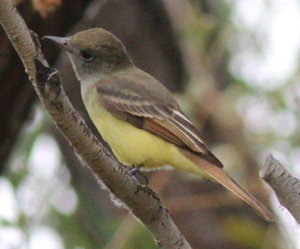
Great-crested Flycatcher, another first for Inyo County
photo by Debby Parker
Further News is that Jim & Debby Parker found yet another first county record when they crossed paths with a Great-crested Flycatcher in Birchim Canyon 6 September. They immediately got the call out and began taking pictures and although a number of people were there quickly and some spent a couple more days scouring the canyon there were no more views of the bird. While those who 'missed' the bird were sad that they didn't personally get to see the bird in Inyo County, there was an aura of excitement by all that the county snagged another species thanks to the Parkers. We all were thrilled at the convincing images that Debby showed and doubled our efforts to refind the bird…but to no avail. Oh, well, they can't all be like the thrasher.
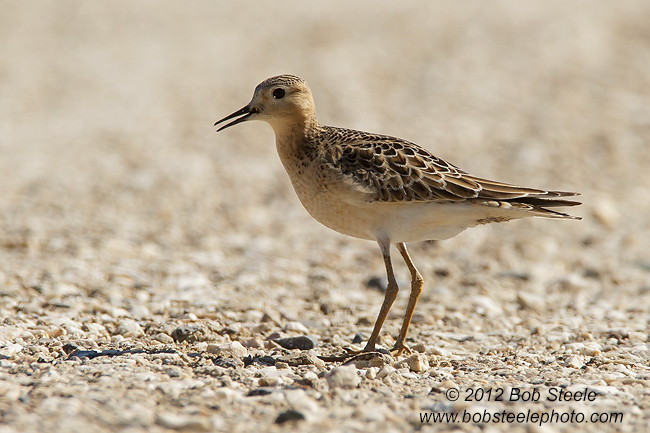
Buff-breasted Sandpiper, photo by Bob Steele
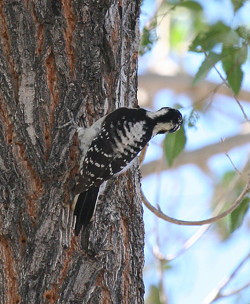
Downy X Nuttall's Woodpecker Hybrid
photo by Kelli Heindel-Levinson
Another great find, the second record ever, was a Buff-breasted Sandpiper at Owens Lake 30 September when Bob & Susan Steele found and photographed the bird and then called people. When they arrived they also got images and the fact that it remained another day was proven when Debbie House took more images on 1 October. This was a juvenile as was the first one that the Steele's found and photographed at Owens Lake 26 August 2007. Equally unusual was the second record ever of a Downy X Nuttall's Woodpecker hybrid that was photographed in the Independence tree lot 28 October by Kelli Heindel-Levinson. Most Nuttall's hybrids in Inyo County are with Ladder-backed Woodpeckers.
A Canada Warbler was found near Warm Springs Road, southeast of Bishop, 13 October by Carolyn Gann and Larry Nahm. They also got the word out and the others who came, conquered, and collected images for the 9th Inyo County record. Remarkable about this record is that it is the latest of the previous eight records and the first one ever recorded in October.
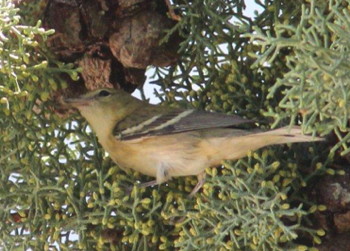
Bay-breasted Warbler, photo by Debby Parker
The 12th Red Knot record occurred when three birds were found at Owens Lake 16 September by Susan Steele and photographed by Susan and Kelli Heindel-Levinson who found one remaining when she returned a week later. All were juveniles, as they should have been, since adults pass through in July and August with only two birds recorded in spring.
An immature Bay-breasted Warbler, the 18th record, was in Rovana 13 September where it was recorded by Jon Dunn, Jim Parker, and Debby Parker, who was able to get some images. Of the 11 fall records, this is the earliest ever and the first September record. Another 18th record was added when Jim Pike recorded a Least Flycatcher at Surprise Canyon 27–28 September.
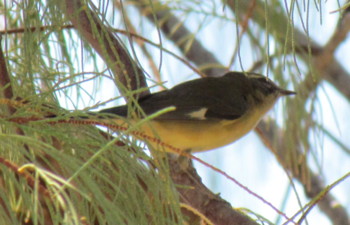
Black-throated Blue Warbler, photo by Jim Pike

Bay-breasted Warbler, photo by Debby Parker
Two Black-throated Blue Warblers were reported this fall becoming the 35th and 36th county records for the species. The first one was an adult female at Furnace Creek Inn 12 September photographed by Jim Pike and was the second earliest fall arrival ever. The other was also a female at China Ranch 14 October recorded by Chris & Rosie Howard that was only the second time the species had been found at China Ranch in October.
The 39th record of a Gray Catbird was at Crystal Spring, Kingston Range in the southeast part of the county, and photographed by Chris & Rosie Howard. Since this was the third record for 14 October, we are considering naming it Catbird Day. At the same location, on the same day, and by the same observers, a Purple Finch, was recorded for the 40th time. It was an immature male practicing the song he will use to woo the females next spring. It, like the catbird, tried to avoid Chris's camera but identifiable images were obtained to validate that this frequently mis-identified species is a reliable record. The male Prothonotary Warbler recorded at Deep Springs College 3 September by Susan Steele was the second earliest fall arrival ever for the species. The 48th record of a Grasshopper Sparrow was recorded when Curtis Marantz photographed the bird that Andrew Howe found at Furnace Creek Ranch 3 November.
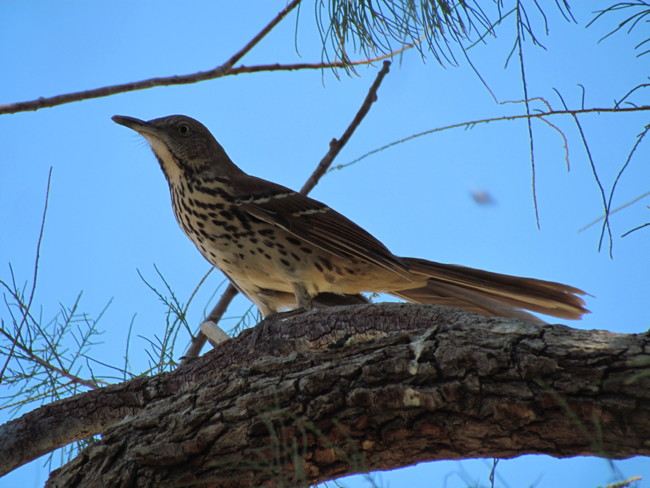
Brown Thrasher, photo by Jim Pike
The 50th record of a Brown Thrasher occurred when Jim Pike photographed the bird 29 September near the Emigrant Ranger Station and the 60th record of a Mountain Plover was recorded on 27 November in southern Bishop when Jim and Debby were able to photograph it and call others who also were able to see and photograph the bird. It lingered through 30 November allowing a number of people viewing opportunities.
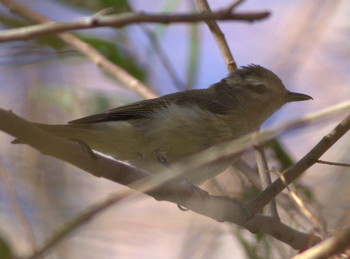
Warbling Vireo
photographed in November by Curtis Marantz
How can we ignore the ghostly and graceful White-tailed Kites. Two spent the fall in Bishop and on 3 November three were recorded in the county at the same time…an event that has only occurred once before in the county from December 1994 to March 1996 when a small group was at Fort Independence. Or the Cassin's Kingbird with 111 records, but on 6 November James & Kay Wilson recorded one near Bishop for the latest record ever. Or the Warbling Vireo, a common migrant and summer resident, that was recorded at Shoshone 3 November by Curtis Marantz for the second latest record ever for that species. Or the House Wren with over 1600 records but none recorded as high as 11,352ft/3461m, which happened when Chris and Rosie Howard noted one near Bishop Pass 4 August.
Inyo County had a truly amazing Fall and as reports were sent in, they were accompanied with notes from the many observers complaining that Fall went by too fast. Isn't that what is supposed to happen when you are having too much fun?
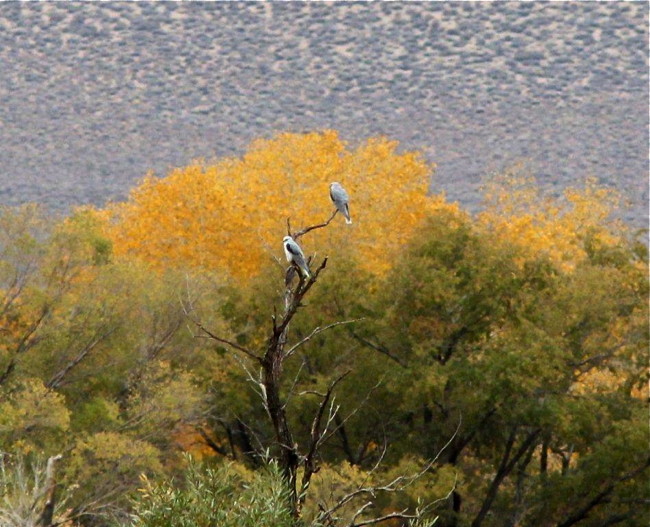
White-tailed Kites, stunning against the late fall colors this November off Brockman in Bishop
Photo by Debby Parker
Back to Top
500 & Rising - Sierra Bighorns and the Migrating Mural Project
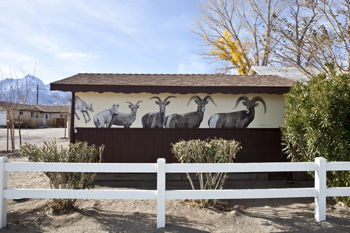
Bighorn Mural Migrates to Independence
Ever since the precipitous decline that landed Sierra Nevada bighorn sheep on the Federal endangered species list, teams of researchers have monitored the population closely to ascertain its progress toward recovery. Over the past year, successful surveys and the discovery of newly-occupied sheep habitat have led to an exciting conclusion: there may now be as many as 500 Sierra bighorn in our mountains. While the road to full recovery is long, this number represents significant and promising growth from a population low of 100 animals in 1995.
This great news coincides with another noteworthy occasion: the completion of the first mural in Jane Kim’s revolutionary Migrating Mural project. Jane, an artist and science illustrator, plans to raise awareness about wildlife conservation through a series of murals painted along migration corridors shared by people and endangered animals. The first chapter of the Migrating Mural will showcase Sierra bighorn in four sites along Highway 395, in the shadow of the bighorns’ home range. By bringing this rare and magnificent animal into the public eye, Jane hopes to generate community support that will help protect Sierra bighorn forever.
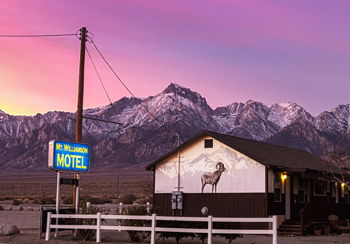
Bighorn Mural Migrates to Independence
Battling rain, wind, and temperatures cold enough to freeze her paints, Jane completed the first mural in late November on the walls of the Mount Williamson Motel in Independence. Easily seen from the highway, the mural depicts the growth stages of a bighorn ram from a two-month-old lamb to an eight-year-old adult. Jane’s work has given the elusive bighorn a place on the center stage of our community, and it has been truly rewarding to watch her turn her artistic ideals into a powerful conservation statement.
In celebration of Jane's Migrating Mural project and of the growth of the Sierra bighorn population, the Sierra Nevada Bighorn Sheep Foundation will host a fundraiser on Saturday, February 16, 2013 at The Mountain Light Gallery (106 S Main Street, Bishop). Please join in for an evening of fine art, light refreshments, conversation about conservation, and a chance to win terrific prizes via raffle and silent auction. John Wehausen, the leading authority on Sierra Nevada bighorn sheep, will lead a bighorn tracking field trip the day after the party on Sunday, February 17. For more information and to purchase tickets, visit www.sierrabighorn.org or www.sagetosummit.com. Don’t miss the chance to learn more about this inspiring new alliance of art and science in the Eastern Sierra.
Back to Top
Reports
Field Trip Report:
Crowley Lake Birding with Jon Dunn, December 1st
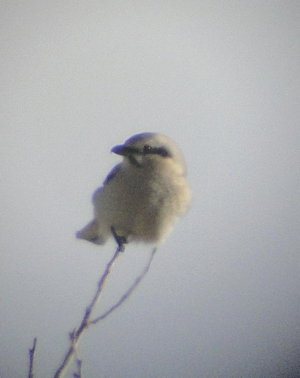
Northern Shrike, photo by Nancy Overholtz
During a brief break in the weather, nine participants rolled up Sherwin Grade to ice-free Crowley Lake, passing a Rough-legged Hawk en route. Near Whitmore Pool, a Northern Shrike – a life bird for some – took a typically high perch, allowing good scoping. On a lakelet swam three gull species: California, Ring-billed and Herring. Several stops at Crowley yielded Prairie Falcon, Bald Eagle, Golden Eagle, Common Loon and at least eight kinds of ducks. Geese included Canada, Cackling, Snow and Ross's. On the east shore, we braved breezes to scope a Greater Yellowlegs and our fourth gull species, a pair of Bonaparte's, very late migrants. Lined up in the distance like pickets were Great Blue Herons ("the poor man's Sandhill Cranes"). The party finished in the Owens Valley, off Sunland Road near Bishop, looking in vain for Mountain Plovers which had been spotted. But we enjoyed another Prairie Falcon, and Mountain Bluebirds, Horned Larks and American Pipits in flocks. Thanks to Jon Dunn, with whom birding is always great fun, and always a matchless learning experience.
Larry Nahm
Back to Top
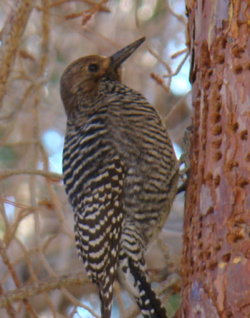
Williamson's Sapsucker
Photo by John and Ros Gorham
Bishop Christmas Bird Count Results
Click on any photo or linked species for a slideshow
The 31st annual Bishop Christmas Bird Count was held on December 15, 2012. A record 61 participants tallied a record 118 species. One additional species, a Fox Sparrow, was observed during Count Week. The weather was cool but pleasant with a low of 22°F and a high of 45°F with mostly sunny skies and virtually no wind.
Several species were new to the count this year: a Short-eared Owl was observed hunting Round Valley fields. A cooperative female Williamson's Sapsucker was photographed at Plant 4. A Yellow-shafted Northern Flicker female was in Round Valley. A well-described "Solitary" Vireo in West Bishop residential may have been a Blue-headed Vireo, but distant views were insufficient to narrow down to species. A Black-and-White Warbler worked Cottonwood trunks in the Bishop City Park.
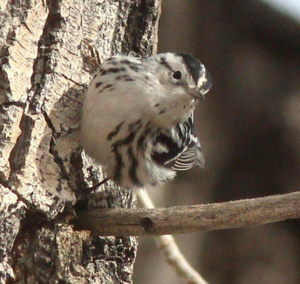
Black-and-White Warbler
Photo by Debby Parker
Other rarities included three Rough-legged Hawks in Round Valley, a Burrowing Owl along a dry ditch at the south end of Barlow, a female Costa's Hummingbird at a Starlite feeder, an adult male Vermilion Flycatcher continued at the Bishop Golf Course, and a female Vermilion Flycatcher also at the golf course was a surprise. A Pacific Wren worked a Round Valley brush pile. Two Vesper Sparrows on Sunland fed on the ground with a continuing Lark Bunting. A Swamp Sparrow was photographed along the Owens River at Pleasant Valley Campground. An immature Harris's Sparrow was with juncos along Round Valley Road. A nicely-marked "Pink-Sided" Dark-Eyed Junco at Millpond was carefully studied and well-described.
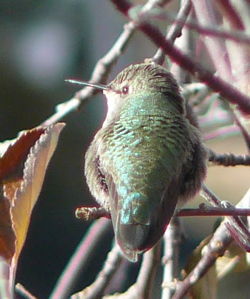
Female Costa's Hummingbird
Photo by Chris Howard
The record number of participants certainly assisted in establishing the following High Counts (HC): Great Blue Heron (46), Sharp-shinned Hawk (14), Eurasian Collared-Dove (333), a whopping 10 Anna's Hummingbirds were all near feeders, Belted Kingfisher (22), Red-naped Sapsucker (10), Hairy Woodpecker (18), Black Phoebe (40), Vermilion Flycatcher (2), Loggerhead Shrike (38), American Crow (244), Horned Lark (2206), Red-breasted Nuthatch (7), White-breasted Nuthatch (3), Western Bluebird (44), Townsend's Solitaire (5), Lark Sparrow (7), House Finch (469).
For a detailed summary (pdf) of the results, click here.
Many thanks to all the talented and generous people who contribute to the Bishop CBC, and many thanks to Chris Howard, the Bishop Christmas Bird Count Compiler, for sharing the information on the count. Mark your calendars for the next Bishop CBC on Saturday, December 14, 2013.
Chris Howard
Bishop CBC compiler
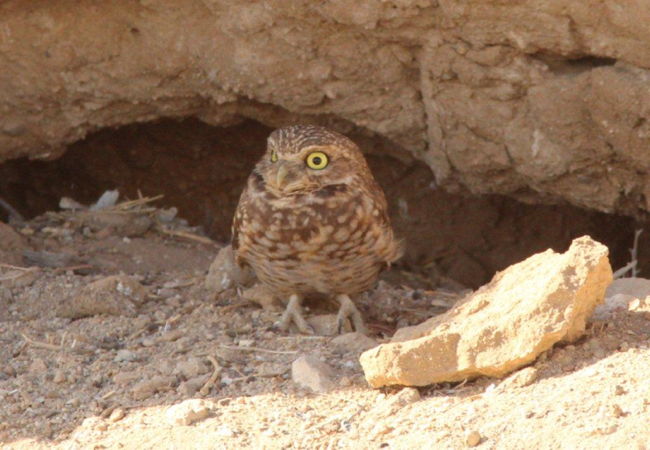
Burrowing Owl, photo by Debby Parker
Back to Top
Bird-a-Thon is Not Over!
The Christmas Bird Count may be over, but it's not too late to donate to Eastern Sierra Audubon, through the Bird-a-Thon, through a Chapter Membership, or through a cash donation. Our Bird-a-Thon did not raise as much money this year as it has in the past, and we have some extra expenses as well, which has led to a budget shortfall this year of about $1400. We hope to make this up through fundraising and memberships by the end of this fiscal year (end of June). We need the funding in order to continue our scholarship program for local High School seniors, plus other educational efforts we have done for years such as Birds in the Classroom and special events, as well as being able to offer excellent programs and field trips, to participate in the annual Bird Chautauqua and other community events. We are an all volunteer-run nonprofit and depend on the support of our community to be able to give back through our programs.
If you'd like to support all that we do for birds and wildlife and people, please consider joining or renewing your membership. A Chapter Membership ensures all of your money goes to local projects, though we do get a small portion of National Memberships as well. Mail Bird-a-Thon donations, general donations, and/or membership formsto Eastern Sierra Audubon, PO Box 624, Bishop, CA 93514, or bring them to our next program and put them in the donation jar or give them to a board member. We sincerely thank you for your support!
Back to Top
Passing of a Birding Great
Rich Stallcup, well-known to many here in the eastern Sierra for his popular (sold-out almost immediately) Bird Chautuaqua field trips, passed away last December 15th while so many were out counting birds. What a fitting, if unbeknownst, tribute. Thank you, Rich, for sharing your knowledge and love of birds - you will be missed.
Wonderful tribute by Kenn Kaufman: So Long, Rich
Share your thoughts at PRBO: Rich Stallcup (1944-2012) A champion for conservation and all things wild
Back to Top
Taking Care of Business
Welcome New and Renewing Members!
Eastern Sierra Audubon would like to thank the following new and/or renewing members for their support:
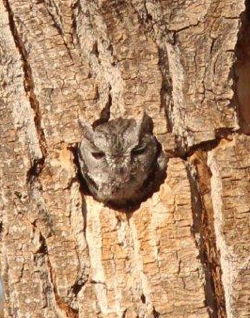
Western Screech-Owl
Photo by Debby Parker
- Cole Hawkins
- Elizabeth Quinn
- Joanna Burkhardt
- Mr. & Mrs. Charlotte Harbeson
- Rich & Carol Ann Mitchell
- Rhonda & Hank Starr-Garretson
- Edie Trimmer
- Mr. Scott Weaver
Your membership donations help keep this chapter alive. We get 8-10 renewing members a month, and from 3-5 new members. Your membership dues make it possible for us to offer and support great educational and recreational events throughout the eastern Sierra. Thank you!
If you would like to join and help support Eastern Sierra Audubon, there are two ways you can do it:
- Join as a National Audubon Society Member, designating ESAS as your chapter affiliation. Includes Audubon Magazine subscription. This is $20 for the first year, and goes up to $35 annually thereafter.
- Join as an ESAS Chapter-only member for $20 per year. Now that we do the newsletter online, you no longer need to join to receive it, but your chapter membership is a way to give back, and show your appreciation for all that ESAS does, and to help support our many programs.
Click Here for a membership form to join or renew!
Join National Audubon - your zip code will associate you with the chapter nearest you.
Back to Top
How You Can Help ESAS: Four R’s (and a V)
Renew your membership (or join): The money from your membership dues is what helps us bring great evening programs, special events, educational programs, trips, this website, and more to the community - we need your support!
Recycle at Manor Market and tell them to donate the money to Eastern Sierra Audubon.
Respect property and get permission to bird on private or restricted access property.
Repeat: Spread the word about programs and events, encourage others to join and participate.
Volunteer: Come to a board meeting and consider volunteering for an open board position! We welcome new board members, and we also always need volunteers for Birds in the Classroom, participants in bird counts, Bird-A-Thons, etc.
Message from the Editor
Winter Returns!
So nice to have a "real" winter again! In spite of the extra cold weather we've been having, the Christmas Bird Count had record numbers, including hummingbirds! If you didn't make your Bird-a-Thon pledge yet, it's not too late, even though the count is over for this year.
Our next newsletter deadline will be February 15th for the
March-April issue, and of course you are always welcome to send submissions for future newsletters
and also the monthly email at any time.
We send out no more
than one (or rarely two) emails each month to remind you of upcoming events - if you are not
on our email list, please
add yourself so you don’t miss anything! If you send items to the newsletter
editor by the last week of any month, we’ll make sure they get included in
the next issue.
Please Contribute!
Speaking of sending in items for the newsletter...
All of our content is supplied by our awesome members... if you have any ideas about articles you’d like to see, or better yet, if you have anything to share for newsletter publication, whether an article, a news item, update, correction, poem, essay, artwork, photo, field trip report, neat birding experience, letter, etc, please send it, along with any comments or suggestions, to the newsletter
editor. We’d love to hear from you!
You may send items for inclusion in the newsletter at any time, but please
send any timely items to arrive before the first of the month, so they can
be included in the monthly email update.
Thanks for reading, and happy birding!
Maggie Wolfe Riley, Newsletter Editor
Back to Top
About Eastern Sierra Audubon
Current Board Members
Membership
Main Calendar of Events
Calendar for January and February
Back to Top
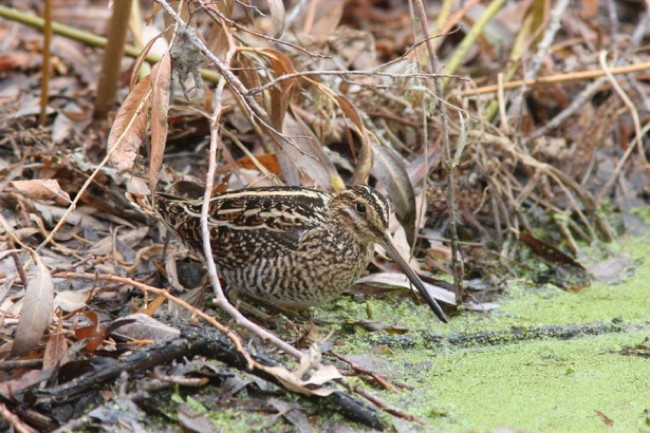
Wilson's Snipe, Birchim backwater, photo by Debby Parker
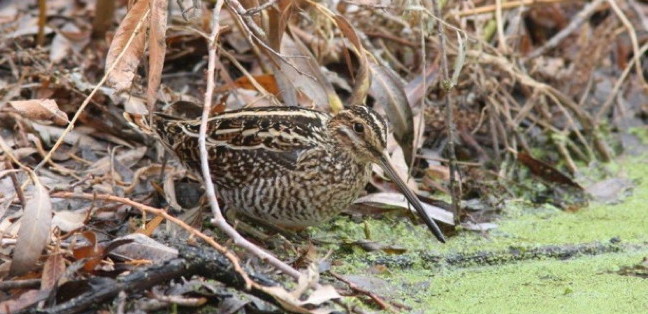
Wilson's Snipe, Birchim backwater, photo by Debby Parker
